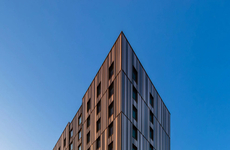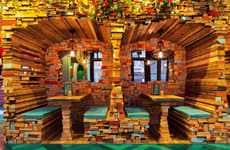
Hoflab Completes the Unified Building Institutions in Italy
Jamie Danielle Munro — May 14, 2014 — Art & Design
References: hoflab.it & designboom
Located in Italy, the Unified Institutions building in Italy completed by Hoflab is as energy efficient as possible. The architects wanted the headquarters to be modern in more ways than just looks, so took the time to ensure the structure did not have a massive carbon footprint.
To do this the firm used a "metal sunscreen, small scale wind turbines, as well as [a] solar thermal and photovoltaic system," as stated on DesignBoom. All of these aspects helps to contribute to the energy efficient abilities of the Unified Institutions building in Italy, while still making the entire piece of architecture look good. Everything blends in well with the surroundings so that the headquarters don't stick out amongst the natural environment, which can really take away from the final structure.
Photo Credits: designboom, hoflab.it
To do this the firm used a "metal sunscreen, small scale wind turbines, as well as [a] solar thermal and photovoltaic system," as stated on DesignBoom. All of these aspects helps to contribute to the energy efficient abilities of the Unified Institutions building in Italy, while still making the entire piece of architecture look good. Everything blends in well with the surroundings so that the headquarters don't stick out amongst the natural environment, which can really take away from the final structure.
Photo Credits: designboom, hoflab.it
Trend Themes
1. Energy Efficiency - The Unified Institutions building in Italy showcases innovative energy-saving technologies such as metal sunscreen, wind turbines, solar thermal, and photovoltaic systems.
2. Sustainable Architecture - Hoflab's design for the headquarters demonstrates a commitment to blending modern aesthetics with environmentally friendly features, creating an opportunity for disruption in sustainable architectural practices.
3. Integration of Natural Surroundings - The seamless integration of the building with the natural environment allows for a harmonious experience and opens up possibilities for disruptive innovations in landscape architecture.
Industry Implications
1. Green Building - The Unified Institutions building in Italy exemplifies the potential for disruptive innovation in the green building industry by incorporating energy-efficient technologies.
2. Renewable Energy - The use of wind turbines and solar thermal systems in the building presents an opportunity for disruptive innovation in the renewable energy industry.
3. Environmental Design - The integration of natural surroundings into the building design highlights the potential for disruptive innovations in the field of environmental design and landscape architecture.
0.8
Score
Popularity
Activity
Freshness























